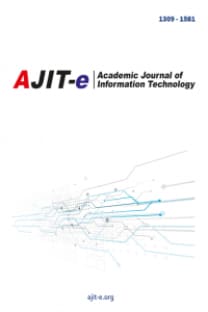Farklı Kültürlerden Öğrenenler İçin Uzaktan Ders Tasarım İlkelerinin Belirlenmesi ve Öğrenen Görüşleri
Culturally Sensitive Instructional Design for Distance Learners and Experiences
Culture, multiculturalism, cultural diversity, cultural sensitivity, distance learning, distance education, online learning online education, e-Learning, course design.,
___
- Abu-Taieh, E. (2014). Gender digital divide and social media (Facebook): Female using social media and the effect of literacy rate and gdp (ppp) and country location. International Journal of Social Science & Interdisciplinary Research, 3(6), 132-147.
- Allen, B. A. ve Boykin, A. W. (1992). African-American children and the educational process: Alleviating cultural discontinuity through prescriptive pedagogy. School Psychology Review, 21(4).
- Aydın, C. H. ve McIsaac, M. S. (2004). The impact of instructional technology in Turkey. Educational Technology Research and Development, 52(1), 105-112.
- Babbie, E. (2008). The basics of social research. (4. baskı). Belmont, CA: Thomson/Wadsworth.
- Carifio, J. ve Perla, R. J. (2007). Ten Common Misunderstandings, Misconceptions, Persistent Myths and Urban Legends about Likert Scales and Likert Response Formats and their Antidotes. Journal of Social Sciences, 3 (3), 106-116.
- Gavrila, M-G. ve Brandt, D. (2013). The impact of cultural distance on the success and stability of international cooperation forms: Student organizations. IFAC Proceedings Volumes, 46(8), 89-94. Doi: 10.3182/20130606-3-XK-4037.00023
- Goodfellow, R. ve Lamy, M. N. (2009). Introduction: A frame for the discussion of learning cultures. R. Goodfellow ve M. N. Lamy (Eds.), Learning cultures in online education içinde (s. 1-14). London: Continuum Books.
- Gudykunst, W. B. ve Lee, C. M. (2002). Cross-cultural communication theories. W. B. Gudykunst ve B. Mody (Eds.), Handbook of international and intercultural communication (2. basım) içinde (s. 25-51). Thousand Oaks, CA: Sage.
- Gunawardena, C. N., Wilson, P. L. ve Nolla, A. C. (2003). Culture and online education. M. Moore ve B. Anderson (Eds.), Handbook of distance education içinde (s. 753-775). Mahwah, New Jersey: Lawrence Erlbaum Associates.
- Gunawardena, C. N. ve Zittle, F. J. (2009). Social presence as a predictor of satisfaction within a computer mediated conferencing environment. American Journal of Distance Education, 11(3), 8-26. Doi: 10.1080/08923649709526970
- Gunawardena, C. N. (2014). Globalization, culture, and online distance learning. O. Zawacki-Richter ve T. Anderson (Eds.), Online distance education towards a research agenda içinde (s. 75-109). Edmonton: AU Press.
- Gürsoy, H. (2005). A critical look at distance education in Turkey. A. A. Carr-Chellman (Ed.), Global perspectives on e-Learning: Rhetoric and reality içinde (s. 115-126). USA: Sage Publications.
- Güvenç, B. (2002). Kültürün ABC’si. (2. baskı). İstanbul: Yapı Kredi Yayınları.
- Güvenç, B. (2010). İnsan ve kültür. İstanbul: Boyut Yayıncılık.
- Hall, E. T. (1976). Beyond culture. NY: Anchor Press.
- Hall, E. T. (1990). The silent language. New York: Anchor Books.
- Hofstede, G. (1983). National cultures in four dimensions: A research-based theory of cultural differences among nations. International Studies of Management & Organization, 13(1), 46-74. Doi: 10.1080/00208825.1983.11656358
- Hofstede G., Hofstede G. J. ve Minkov M. (2010). Cultures and organizations: software of the mind: Intercultural cooperation and its importance for survival. (3. baskı). New York: McGraw Hill.
- Hofstede, G. (2014, Aralık 08). National Cultural Dimensions. [Web sayfası]. http://geerthofstede.nl/dimensions-of-national-cultures
- Holliday, A. (1994). Appropriate methodology and social context. UK: Cambridge University Press.
- Kaasa, A. (Ocak 2013). Culture as a possible factor of innovation: Evidence from the European Union and neighbouring countries.
- Kartal, G., Toprak, E. ve Genç Kumtepe, E. (2015). Course design for culturally diverse learners. Pixel (Ed.), 5th International The Future of Education Conference Proceeding içinde (s. 44-48). Italy: Libreriauniversitaria.it Edizioni.
- Khan, B. (2005). Managing e-Learning strategies: Design, delivery, implementation and evaluation. Hershey, PA: Information Science Pub.
- Moore, M. G. (1972). Learner autonomy: The second dimension of independent learning. Convergence, 5(2), 76-88.
- Moore, M. G. (1980). Independent study. R. Boyd ve J. Apps (Eds.) , Redefining the discipline of adult education içinde (s. 16-31). San Francisco, CA: Jossey-Bass.
- Moore, M. G. (1993). Theory of transactional distance. D. Keegan (Ed.), Theoretical principles of distance education içinde (s. 22-38). New York: Routledge.
- Moore, M. G. ve Kearsley, G. (1996). Distance education a systems view. Belmont: Wadsworth.
- Moore, M. G., Shattuck, K. ve Al-Harthi, A. (2005). Cultures meeting cultures in online distance education. Journal of e-Learning and Knowledges Society, 1(2). Doi: 10.20368/1971-8829/670
- Morgan, C. K. ve Tam, M. (1999). Unravelling the complexities of distance education student attrition. Distance Education, 20(1), 96-108. Doi: 10.1080/0158791990200108
- Steuer, J. (1992). Defining virtual reality: Dimensions determining telepresence. Journal of Communication, 42(4), 73-93.
- Tu, C. (2001). How Chinese perceive social presence: An examination of interaction in online learning environment. Educational Media International, 38(1), 45-60. Doi:10.1080/09523980010021235
- Tylor, E. (1871). Primitive culture: Researches into the development of mythology, philosophy, religion, art, and custom. London: J. Murray.
- Wilson, M. S. (2001). Cultural considerations in online instruction and learning. Distance Education, 22(1), 52-64. Doi: 10.1080/0158791010220104
- Yayın Aralığı: Yılda 4 Sayı
- Yayıncı: AKADEMİK BİLİŞİM ARAŞTIRMALARI DERNEĞİ
Hastane İnovatif Faaliyetlerinin Algılanan Hizmet Kalitesine Etkisi: Devlet Hastanesi Örneği
Gamze YORGANCIOĞLU TARCAN, Ayça KARAHAN, Menderes TARCAN
Çin Halk Cumhuriyeti’nde Yeni Medya Uygulamaları: Nitel Bir Araştırma
Sefer KALAMAN, Elif KAYA, Ünal KAYA
Tüketicilerin Youtuber’lara Yönelik Algılarının İncelenmesi: Türkiye Örneği
Sosyal Medya ve Değişim: Bloglar Aracılığıyla Anneliğin Evrimi Üzerine Netnografik Bir Analiz
Ercan AKTAN, Hasan Hüseyin KAYIŞ
Türkiye’de E-devlet Hizmetlerinin Kabulü
E-ticaret Müşteri Bağlılığı Gri İlişkisel Kümeleme Analizi
Dijital Oyunlarda Bağımlılık ve Şiddet: Blue Whale Oyunu Üzerinde Bir İnceleme
Sistem Geliştirme: Web Tabanlı Uzaktan Eğitim ile Trafik Kazalarının Önlenmesi
Zamanlar Bağlamında İngilizce Öğretimi İçin Bir Mobil Uygulama Tasarımı: SOS Tablosu
